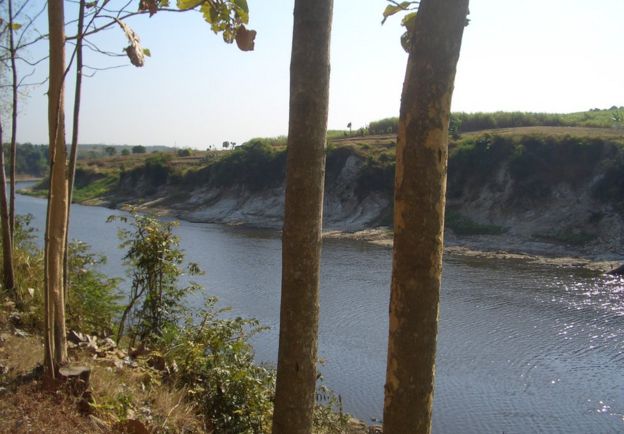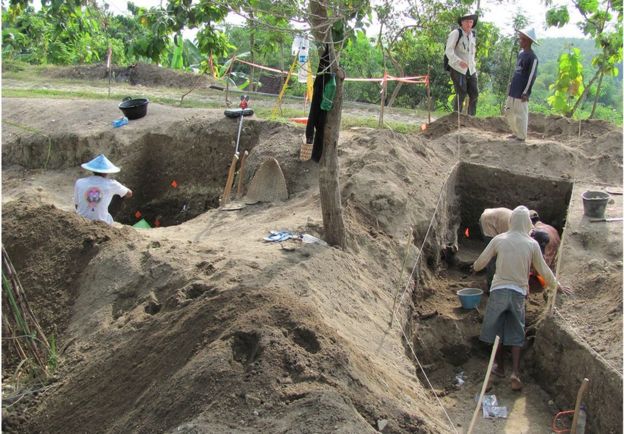Homo erectus: Ancient humans survived longer than we thought
 SCIENCE PHOTO LIBRARY
SCIENCE PHOTO LIBRARY
An ancient relative of modern humans survived into comparatively recent times in South East Asia, a new study has revealed.
Homo erectus evolved around two million years ago, and was the first known human species to walk fully upright.
New dating evidence shows that it survived until just over 100,000 years ago on the Indonesian island of Java - long after it had vanished elsewhere.
This means it was still around when our own species was walking the Earth.
Details of the result are described in the journal Nature.
In the 1930s, 12 Homo erectus skull caps and two lower leg bones were found in a bone bed 20m above the Solo River at Ngandong in central Java.
In subsequent decades, researchers have attempted to date the fossils. But this proved difficult because the surrounding geology is complex and details of the original excavations became confused.
- New human species found in Philippines
- Study backs 'hobbit' shrinking idea
- Age of 'Hobbit' species revised
 TIM SCHOON/UNIVERSITY OF IOWA
TIM SCHOON/UNIVERSITY OF IOWA
In the 1990s, one team came up with unexpectedly young ages of between 53,000 and 27,000 years ago. This raised the distinct possibility that modern humans overlapped with Homo erectus on the Indonesian island.
Now, researchers led by Prof Russell Ciochon of the University of Iowa in Iowa City opened up new excavations on the terraces beside the Solo River, reanalysing the site and its surroundings.
They have provided what they describe as a definitive age for the bone bed of between 117,000 and 108,000 years old. This represents the most recent known record of Homo erectus anywhere in the world.
"I don't know what you could date at the site to give you more precise dates than what we've been able to produce," Prof Ciochon told BBC News.
Prof Chris Stringer, research leader on human evolution at London's Natural History Museum, who was not involved with the work, commented: "This is a very comprehensive study of the depositional context of the famous Ngandong Homo erectus partial skulls and shin bones, and the authors build a strong case that these individuals died and were washed into the deposits of the Solo River about 112,000 years ago.
"This age is very young for such primitive-looking Homo erectus fossils, and establishes that the species persisted on Java for well over one million years."
Researchers think the collection of remains represent a mass death event, possibly the result of a lahar upriver. A lahar - which comes from a Javanese word - is the slurry that can flow down the slope of a volcano when heavy rainfall occurs during or after a volcanic eruption. These violent events will sweep away anything in their path.
Previously, team-member Frank Huffman, from the University of Texas at Austin, had tracked down the descendants of the Dutch researchers who excavated the Homo erectus remains back in the 1930s.
 KIRA WESTAWAY, MACQUARIE UNIV
KIRA WESTAWAY, MACQUARIE UNIV
The relatives were able to provide him with photographs of the original dig, maps and notebooks. Huffman was able to resolve much of the uncertainty that had hampered previous attempts to understand the site.
"He was able to tell us exactly where to dig," Prof Ciochon said of the University of Texas researcher.
Ciochon and his colleagues excavated part of an untouched reserve area left alone by the Dutch team in the 1930s. Informed by records of the original excavations, the team was able to identify the gravelly deposit - or bone bed - from which the Homo erectus fossils had come, and date it.
On other islands in South-East Asia, Homo erectus appears to have evolved into smaller forms, such as Homo floresiensis - the "Hobbit" - on Flores, and Homo luzonensis in the Philippines. This probably occurred because there were limited food resources on these islands. But on Java, there appears to have been enough food for erectus to maintain its original body size.
The specimens at Ngandong appear to be between 5ft and 6ft in height - comparable to examples from Africa and elsewhere in Eurasia.
 RUSSELL L. CIOCHON, UNIV. OF IOWA
RUSSELL L. CIOCHON, UNIV. OF IOWA
The findings further underline the shift in thinking this field of study has undergone over the decades. We used to think of human evolution as a progression, with a straight line leading from apes to us. This is embodied in the so-called March of Progress illustration where a stooping chimp-like creature gradually morphs into Homo sapiens, apparently the apex of evolution.
These days, we know things were far messier. The latest study highlights a mind-boggling truth: that many of the species we thought of as transitional stages in this onward march overlapped with each other, in some cases for hundreds of thousands of years.
But why did Homo erectus survive so late on Java? In Africa, the species was probably gone by 500,000 years ago; in China it vanished some 400,000 years ago. Russell Ciochon thinks that it was probably outcompeted by other human species elsewhere, but Java's location allowed it to thrive in isolation.
However, the results show the fossils came from a period when environmental conditions on Java were changing. What were once open woodlands were transforming into rainforest. Prof Ciochon thinks this could mark the exact point of extinction of Homo erectus on the island.
Last appearance?
No Homo erectus are found after this time, he explained, and there's a gap with no human activity at all until Homo sapiens turns up on Java around 39,000 years ago. Prof Ciochon believes H. erectus was too dependent on the open savannah and too inflexible to adapt to life in a rainforest.
"Homo sapiens is the only hominin species that lives in a tropical forest," he explained. "I think it's mainly because of the cultural attributes of Homo sapiens - the ability to make all these specialised tools."
"Once this rainforest flora and fauna spread across Java, that's the end of erectus."
But Chris Stringer sounded a note of caution.
"The authors claim that this is therefore the last known occurrence of the species, and that this indicates there was no overlap of the species with Homo sapiens in Java, as H. sapiens arrived much later," he said.
"I'm not convinced about that as other supposedly late Homo erectus material from Javanese sites like Ngawi and Sambungmacan remain to be properly dated, and they may be younger still. Alternatively, they may correlate with the ages of the Ngandong fossils, but that should be the next stage of investigation."
Follow Paul on Twitter.
No comments:
Post a Comment
Note: Only a member of this blog may post a comment.